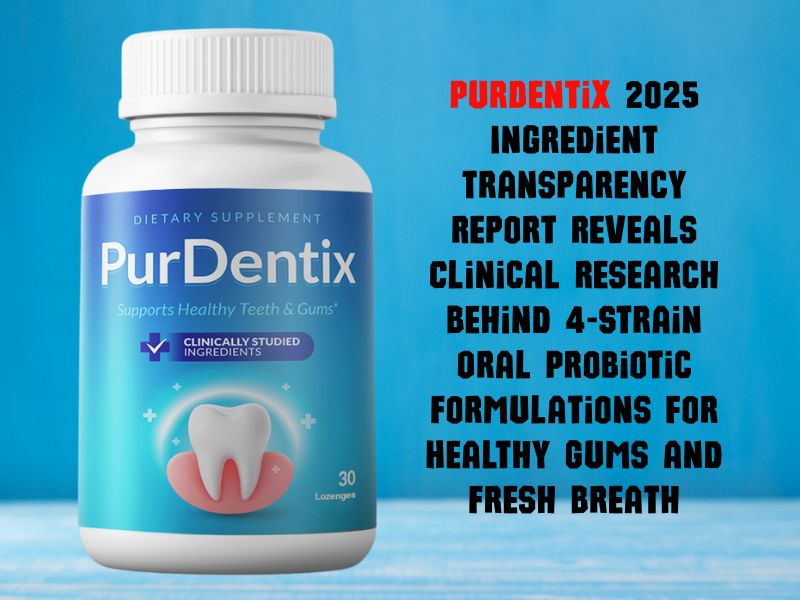The 2025 Ingredient Transparency Report released by PurDentix highlights the clinical research supporting its four-strain oral probiotic formulations designed to enhance gum health and promote fresh breath. The report reflects a growing trend among consumers who prioritize ingredient transparency and scientific validation over mere marketing claims in the oral probiotic supplement industry.
As consumers become more discerning, demand for clear labeling and clinical backing has prompted manufacturers to shift from proprietary blends to strain-specific formulations. This change helps ensure that the health benefits of oral probiotics can be independently verified. According to industry analysts, oral probiotic chewable tablets featuring multi-strain combinations have seen robust growth, particularly those containing strains like Lactobacillus Paracasei, Lactobacillus Reuteri, Bifidobacterium Lactis BL-04, and Lactobacillus Salivarius.
PurDentix Oral Health Probiotic offers a 30-chewable-tablet format that includes these specific strains along with supporting ingredients such as zinc, chicory root, and organic mint. This comprehensive report not only delves into the clinical research backing these formulations but also explores the preference for chewable delivery systems over traditional rinse-based methods.
Understanding the Shift Toward Ingredient Transparency
The oral health supplement market has undergone significant changes in 2025, with a clear move away from generic “probiotic blend” labeling. Today’s consumers demand precise information about the bacterial strains included, their concentrations, and the supporting research that validates their effectiveness. This trend mirrors broader movements within the dietary supplement industry, where consumers expect third-party testing, Certificates of Analysis (COA), and references to published clinical studies as baseline standards.
For oral probiotics, it is essential to differentiate between strains that have demonstrated specific benefits for oral health and those that are primarily used for digestive health. While many products contain common probiotics such as Lactobacillus acidophilus or Bifidobacterium longum, these strains may lack the mechanisms necessary for effective oral cavity colonization.
PurDentix has gained recognition not through promotional claims but by meeting these transparency expectations. By clearly identifying its core strain formula and providing information on supportive ingredients, the brand exemplifies a shift toward evidence-informed product development in the oral health sector.
Clinical Research Insights on Multi-Strain Formulations
The report comprehensively reviews the existing clinical research surrounding the four key probiotic strains. Each strain plays a unique role in supporting oral health:
– **Lactobacillus Paracasei** has shown promise in influencing oral bacterial populations, particularly those linked to periodontal issues. Studies indicate that this strain may aid in improving gum health markers over intervention periods of 4-12 weeks.
– **Lactobacillus Reuteri** has been linked to reducing volatile sulfur compounds, the primary contributors to bad breath. Research suggests that its supplementation can lead to measurable decreases in halitosis, although individual results may vary.
– **Bifidobacterium Lactis BL-04** has been studied for its potential to enhance immune modulation in oral tissues, promoting a more resilient oral microbiome. Increased diversity in bacterial populations following its use has been observed, which can be beneficial for overall oral health.
– **Lactobacillus Salivarius** has been noted for its effects on cariogenic bacteria and its potential to support gum tissue integrity, although findings require further validation through controlled studies.
The report emphasizes that multi-strain formulations like those offered by PurDentix may provide benefits that single-strain products cannot achieve. The combination of multiple strains could enhance colonization across various oral niches, offering broader protection against pathogenic bacteria.
In addition to the probiotic strains, the report highlights the supporting ingredients found in these formulations. Zinc, for example, is frequently included due to its antimicrobial properties and its ability to support gum tissue integrity. Prebiotic fibers, like chicory root, may also enhance the growth and survival of beneficial probiotic bacteria.
The findings outlined in the report reflect a fundamental shift in how oral health supplements are developed and marketed. As the demand for transparency and clinical validation rises, products like PurDentix’s Oral Health Probiotic stand at the forefront of this evolving landscape, aligning with contemporary consumer expectations for quality and efficacy in dietary supplements.







